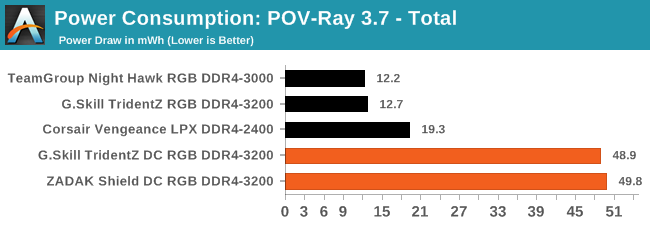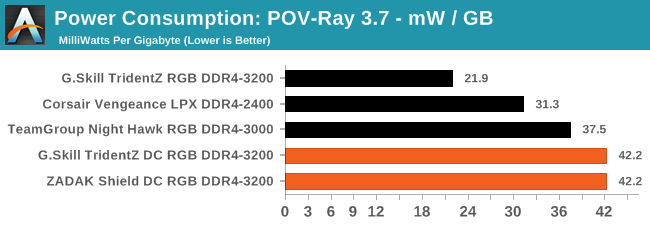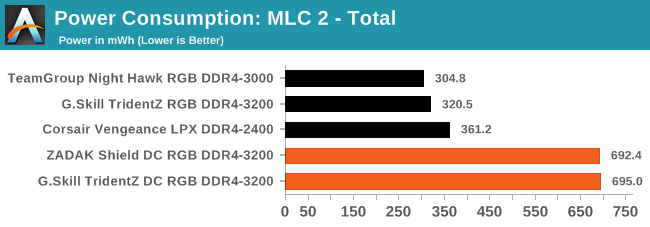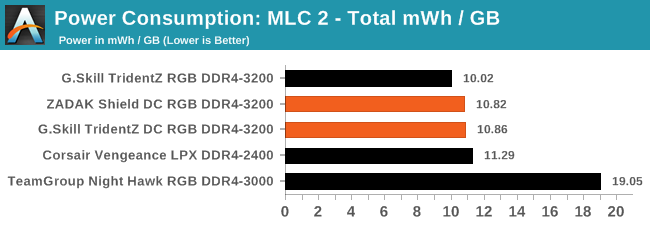Double Height DDR4: 32GB Modules from G.Skill and ZADAK Reviewed
by Ian Cutress & Gavin Bonshor on January 23, 2019 9:00 AM ESTPower Analysis
One of the interesting aspects of the double height memory is how it affects power consumption. It would be natural to assume that double the number of chips and EPROMs would result in double the power draw of a standard capacity module, and the power per GB should be similar.
To measure the power consumption, we ran Intel's Power Gadget 3.5.0 utility during benchmark runs in our POV-Ray 3.7.1 test and in our Memory Latency Checker. POV-Ray 3.7 is a rendering based benchmark which stresses a system - It's a good indicator of memory stability and overall performance so it made it a natural choice for a power point of view. Our second test involves our MLC2 memory benchmark which is purely memory focused and loads the memory with high workloads as well as testing latency.
POV-Ray 3.7: link
The Persistence of Vision Ray Tracer, or POV-Ray, is a freeware package for as the name suggests, ray tracing. It is a pure renderer, rather than modeling software, but the latest beta version contains a handy benchmark for stressing all processing threads on a platform. We have been using this test in motherboard reviews to test memory stability at various CPU speeds to good effect – if it passes the test, the IMC in the CPU is stable for a given CPU speed. As a CPU test, it runs for approximately 1-2 minutes on high-end platforms.

On average when directly comparing the G.Skill TridentZ and TridentZ DC RAM, the power consumption on average in POV-Ray was 285% higher. This is a noticeable jump over two sticks and more than double in terms of overall power used. If we convert this down to average energy per gigabyte:

There is still an additional penalty in energy for using the new modules per GB.
Memory Latency Checker: link
Intel's Memory Latency checker is a tool designed to measure memory latency and bandwidth. MLC measures multiple aspects of DRAM with idle and load latencies, cache to cache data transfer latencies and peak memory bandwidth. The benchmark focuses purely on the memory and is influenced by higher clock speeds and latency timings.

Over a longer duration and in a high memory weighted benchmark such as MLC2, the power variation from the double capacity to the standard was more consistent with what was initially expected; double the power consumption for double capacity RAM. For what it's worth, the Corsair Vengeance LPX kit at 1.2 V was no better off from a power consumption standpoint than the 1.35 V kits tested.

If we compare energy per gigabyte, it is actually very competitive compared to the smaller kits. Here, the 2x8GB kit is actually consuming the most energy per GB, which suggests that the static power is a significant proportion of this analysis.










50 Comments
View All Comments
Alim345 - Wednesday, January 23, 2019 - link
It’s not clear whether it is possible to use four sticks. Probably it is not since those sticks replicate what should happen in motherboard.Targon - Thursday, January 24, 2019 - link
Much of that would be a function of the chipset/BIOS and the memory controller which is on the CPU these days. These double height modules can't directly talk to the memory controller as if they are two modules, because the memory slots themselves and how they talk to the chipset/memory controller/CPU are not different.That is why I wanted to see at least an attempt to get these to work with a socket AM4 system and see how they show up. Going from 1T or 2T to 2T or 4T for the memory is probably the issue, and if the chipset would even allow it. Asking Asus if they have plans to allow DDR4 to run with a 4T command rate on more boards would be worth the call.
nevcairiel - Wednesday, January 23, 2019 - link
Since one of those DIMMs basically acts like two DIMMs, you probably cannot use two of them on the same channel, since that would require supporting 4 DIMMs on the same channel.Targon - Thursday, January 24, 2019 - link
I don't think it works that way. Yes, internally each one is working as if it was two, but how the module talks to the BIOS/chipset/processor is the big question. Does the BIOS need to support a 4T command rate on the memory for these to work, and if so, that explains why support is limited.Bp_968 - Thursday, January 24, 2019 - link
He explained in the article that the way memory channels are handled that the traces are daisy chained or combined. These dimms act as 2 dimms slapped onto one card and won't work stacked 2 too a channel (because then you'd have 4 dimms on a channel).Above and beyond that you also have the fact that now 32GB modules exist which render these far less useful. There are very very few scenarios where you'd want 128GB of ram and not want it to be ECC RAM. Any sort of server and many workstation tasks I'd much prefer to use ECC ram instead.
yuhong - Wednesday, January 23, 2019 - link
Even Intel don't usually update ARK or the datasheet.alpha754293 - Wednesday, January 23, 2019 - link
Maybe I'm missinng something here - but I don't understand why people just don't get 32 GB DDR4-2666 ECC Registered DIMMS like this one (https://www.newegg.com/Product/Product.aspx?Item=N... and be done with it?It's going to run about the same price and they can just overclock it.
Wixman666 - Wednesday, January 23, 2019 - link
Because most boards don't run ECC memory. These are a niche product to get 64GB on boards that only have 2 slots. Lots of memory doesn't overclock well. You're making assumptions with your statement that are completely off base.CheapSushi - Thursday, January 24, 2019 - link
Does that mean ECC RAM will NOT WORK AT ALL or just the ECC portion, soft error correcting, won't work but it'll show up like regular RAM?alpha754293 - Thursday, January 24, 2019 - link
I've used ECC memory on consumer grade boards. All that happens is that the ECC part of the ECC, Registered RAM gets disabled and the rest of the DIMM module functions like a UDIMM instead of a RDIMM."You're making assumptions with your statement that are completely off base."
Yes! Which is why I literally said: "Maybe I'm missinng something here - but I don't understand why people just don't get 32 GB DDR4-2666 ECC Registered DIMMS like this one (https://www.newegg.com/Product/Product.aspx?Item=N... and be done with it?"
Lots of memory don't overclock well is just a broad and generic statement that can also be applied to these modules as well.
The fact of the matter is that DDR4-3000 and DDR4-3200 modules ARE overclocked by default anyways because those speeds aren't part of the JEDEC JESD79-4 spec (p.163).
Here is a 32 GB module from Micron Technology, DDR4-3200, ECC Registered: https://www.ebay.com/itm/Micron-MTA36ASF4G72PZ-3G2...
The point being that a) they exist already and b) you should be able to disable the ECC, registered capabilities of these DIMMs. (I've never had a consumer grade board that didn't know how to ignore the ECC registered capabilities of RDIMMs.)
In other words, you can already do this with existing modules that you can buy, at those speeds, "second" hand (which tells you a little bit about the maturity of the tech).